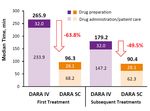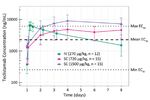MULTIPLE MYELOMA SUPPORTING TRIAL UPDATES FROM ASH 2020 - SUPPLEMENT TO CARE GUIDANCE ON - CARE Education
←
→
Page content transcription
If your browser does not render page correctly, please read the page content below
SUPPLEMENT TO CARE™ GUIDANCE ON
MULTIPLE MYELOMA
SUPPORTING TRIAL UPDATES
FROM ASH 2020
MARCH 2021
TM
www.CAREeducation.ca info@careeducation.ca
Community Academic Research Education CARE Education
@weareCARE www.facebook.com/weareCAREThis report highlights clinical trial updates from ASH 2020. It is meant to provide additional context and support to the CARE™ Guidance on multiple myeloma distributed in February 2021. CARE™ Recommendation: Dara-RD for transplant ineligible patients Click on the CARETM Recommendations to view the full MM Guidance Supporting Trial Highlights from ASH 2020: Updated Analysis of Daratumumab plus Lenalidomide and Dexamethasone (D-Rd) vs. Rd in Patients with Transplant Ineligible Newly Diagnosed MM: The Phase 3 MAIA Study. Shaji K. Kumar et al. • Updated efficacy and safety findings from MAIA after approximately 4 years of follow-up • D-Rd demonstrated a significant benefit in PFS, with a 46% reduction in the risk of progression or death • PFS benefit was generally consistent across subgroups, including patients with high cytogenetic risk (figure 1) • Longer follow-up demonstrated a significant benefit in PFS2 favoring D-Rd versus Rd alone (figure 2) • The MRD-negativity rate was significantly higher in the D-Rd group (31% vs 10%; p
The CARE TM Multiple Myeloma Guidance draws upon insight from both Canadian
and international leaders who have participated in recent CARE TM programs.
To hear more on MAIA from a global perspective access the
recent presentation given by Dr. María Victoria Mateos, MD, PhD
(University of Salamanca, Spain) during the CARETM WHU 2021 live stream!
CLICK HERE TO ACCESS PRESENTATION
Access More On-Demand Content:
https://careeducation.ca/dr-dr-maria-victoria-mateos-multiple-myeloma-whu-2021/
Refer to the end of this report for additional CARETM Hematology Resources
02 SUPPLEMENT TO CARE™ GUIDANCE ON MULTIPLE MYELOMACARE™ Recommendation: Oral and sub-cutaneous drugs reduce time and
frequency of potential exposure so should be prioritized (During COVID-19)
Click on the CARETM Recommendations to view the full MM Guidance
Supporting Trial Highlights from ASH 2020:
Interim* Results of a Time and Motion Survey Regarding Subcutaneous Versus Intravenous Administration
of Daratumumab in Patients with Relapsed or Refractory Multiple Myeloma. Mary Slavcev et al.
• This time and motion survey was undertaken to elicit HCPs’ understanding of workflow and time estimates for administration of
DARA IV and SC (beyond injection time alone)
• Results suggest that DARA SC is associated with less active HCP involvement in drug preparation and administration/patient care
(figure 3) and less patient chair usage as compared to DARA IV
Figure 3. Median HCP Active Time for First and Subsequent Treatment
• When extrapolated for the anticipated number of treatments per year, estimated savings in HCP time per patient for DARA SC vs.
IV was 50% in years 1 and 2
• Shorter administration time could lead to reduced burden on patients and their caregivers, and efficiencies for HCPs and healthcare
institutions allowing for more patients to be treated
* Data collection was halted due to the COVID-19 pandemic so was presented as interim results
03 SUPPLEMENT TO CARE™ GUIDANCE ON MULTIPLE MYELOMACARE™ Recommendation: Novel Regimens to watch for on the horizon
Click on the CARETM Recommendations to view the full MM Guidance
Supporting Trial Highlights from ASH 2020: Early Phase approaches with novel
immune targets
Updated Phase 1 Results of Teclistamab, a B-Cell Maturation Antigen (BCMA) x CD3 Bispecific Antibody,
in Relapsed and/or Refractory Multiple Myeloma (RRMM). Alfred L. Garfall et al.
• Results indicate response is durable and can deepen over time, and that teclistamab has a manageable safety profile, which
includes low-grade CRS (with no gr ≥3 events) and low severe infection and neurotoxicity rates with both IV and SC administration
• The primary objective was to identify a recommended phase 2 dose(s) (RP2D)
• Pharmacodynamics support RP2D of 1500 µg/kg SC (figure 4)
• Of 11 evaluable patients across all IV and SC doses, 8 had MRD- negative CR at 10 -6 and 1 at 10 -5 sensitivity
Figure 4. PK Profile Following Selected IV and SC Doses
CARTITUDE-1: Phase 1b/2 Study of Ciltacabtagene Autoleucel (Cilta-cel), a B-Cell Maturation Antigen–
Directed Chimeric Antigen Receptor T Cell Therapy, in Relapsed/Refractory Multiple Myeloma. Deepu
Madduri et al.
• Cilta-cel has a manageable safety profile and yielded early, deep, and durable responses in heavily pre-treated patients
(96.9% ORR, with sCR 67.0%)
• Median PFS not reached; 12-month PFS rate was 76.6%, OS rate was 88.5%
• Further investigation of cilta-cel in other MM populations is underway, including in earlier-line settings and with outpatient
administration (CARTITUDE-2, and CARTITUDE-4)
• Of evaluable patients, 93% achieved MRD 10 -5 negativity, with a median time of 1 month (0.8-7.7)
04 SUPPLEMENT TO CARE™ GUIDANCE ON MULTIPLE MYELOMAPart 1 Results of a Dose Finding Study of Belantamab Mafodotin (GSK2857916) in Combination with
Pomalidomide (POM) and Dexamethasone (DEX) for the Treatment of Relapsed/Refractory Multiple
Myeloma (RRMM). Suzanne Trudel et al.
Table 1. Summary of efficacy data and corneal toxicity per dosing cohort
Supporting Trial Highlights from ASH 2020: Carfilzomib, Daratumumab, Dex (KDd)
Carfilzomib, Dexamethasone, and Daratumumab Versus Carfilzomib and Dexamethasone in Relapsed or
Refractory Multiple Myeloma: Updated Efficacy and Safety Results of the Phase 3 Candor Study. Meletios A
Dimopoulos et al.
Evaluation of Minimal Residual Disease (MRD) Negativity in Patients with Relapsed or Refractory Multiple
Myeloma Treated in the Candor Study. Ola Landgren et al.
• After a median follow-up of 28 months, median PFS for KDd of 28.6m continues being significantly longer than Kd (15.2m)
• At the 12-month landmark, the MRD-negativity CR rate was 12.5% vs 1.3% in the KdD vs Kd arm (OR, 11.3; POther CARE TM Hematology Resources
Needs Assessments — Share your insights on:
Immune thrombocytopenic
CAR T in Lymphoma
purpura (ITP)
Click Here to Participate
Click Here to Participate
Upcoming Events
Reports & On-Demand Videos
Access Conference Access Guidance &
Report Supplement
06 SUPPLEMENT TO CARE™ GUIDANCE ON MULTIPLE MYELOMAYou can also read



























































